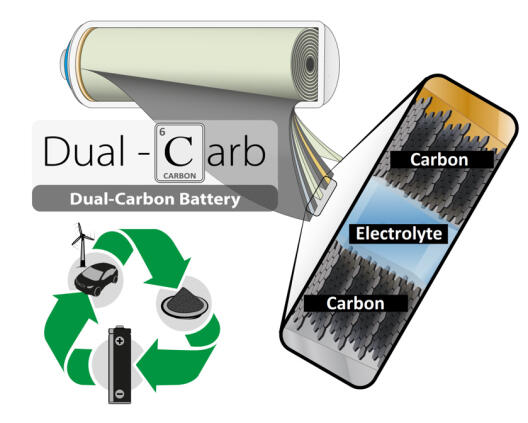Foundation Laid for Advanced Dual-ion Batteries
Low costs and absence of toxic materials: dual-ion batteries have emerged as promising candidate for sustainable energy storage. In an international cooperation project involving MEET Battery Research Center of the University of Münster new insights were gained for a better fundamental understanding of the intercalation mechanisms and the structures of the resulting graphite intercalation compounds (GICs). They serve as a basis for improving the energy density and cycling performance of positive graphite electrodes of dual-ion like dual-graphite batteries and thus represent a further step towards the possible commercialisation of this promising technology.
Focus on the electrolyte
In order to better understand the properties of anion intercalation, the international research team investigated binary highly concentrated mixed electrolytes based on two different lithium salts. The electrolyte functions as active material in dual-ion batteries: instead of just one type of ion - the lithium ion - the electrolyte anions are also involved in energy storage in the dual-ion battery. Dr Tobias Placke, Head of Materials at MEET Battery Research Center, explains: “Despite the central role, the mechanism of anion intercalation and the structures of the resulting GICs are still not sufficiently understood.” The researchers succeeded in identifying GICs at various states-of-charge using in-situ X-ray diffraction studies combined with ex-situ 19F magic angle spinning (MAS) nuclear magnetic resonance (NMR) measurements. They also discovered binary mixture exhibits a significantly enhanced capacity retention after 100 cycles and improved intercalation kinetics - and thus improved conductivity - compared to the single-salt electrolytes. “Based on these findings, further optimisations of electrolytes for dual-ion batteries are possible,” says Dr Tobias Placke.

Detailed results were published in the “Journal of the Electrochemical Society”. Authors are MEET scientists Lukas Haneke, Dr Andreas Heckmann and Dr Tobias Placke as well as Prof. Dr Martin Winter, MEET Battery Research Center and Helmholtz Institute Münster, Joop Enno Frerichs and Prof. Dr Michael Ryan Hansen from the Institute of Physical Chemistry at the University of Münster, Prof. Michael M. Lerner from the Department of Chemistry, Oregon State University (Oregon, USA), Prof. Taner Akbay from the Department of Materials Science and Nanotechnology Engineering, Yeditepe University (Istanbul, Turkey), and Prof. Tatsumi Ishihara from the Department of Applied Chemistry, Faculty of Engineering, Kyushu University (Fukuoka, Japan). The study is embedded in the international cooperation project “Dual-Carb”, which was funded by the German Federal Ministry of Education and Research.
Research on “awarded" technology
The potential of dual-ion batteries as a future technology is also reflected in the ranking of the "Top Ten Emerging Technologies in Chemistry 2020". The International Union of Pure and Applied Chemistry (IUPAC) selected the dual-ion battery as one of the currently most promising technologies that are capable of solving “major global problems” in the future. MEET holds several key patents in this technology and has coined the term “dual-ion batteries”.
The International Union of Pure and Applied Chemistry was founded by chemists from industry and science in 1919. It is the world authority on chemical nomenclature and terminology, including the naming of new elements in the periodic table. IUPAC has 1623 members in 75 countries. Chemists from the University of Münster are also represented there.

